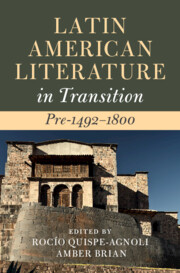Book contents
- Latin American Literature in Transition Pre-1492–1800
- Latin American Literature in Transition
- Latin American Literature in Transition Pre-1492–1800
- Copyright page
- Dedication
- Contents
- Figures
- Contributors
- Acknowledgments
- Introduction Dwelling in Transitions
- Part I Land, Space, Territory
- Part II Body
- Part III Belief Systems
- Part IV Literacies
- Chapter 14 Transcultural Intertextuality in Colonial Latin America
- Chapter 15 Becoming a Book: The Reproduction, Falsification, and Digitalization of Colonial Codices
- Chapter 16 From Print to Public Performance to Relaciones de fiestas: Don Quixote in Viceregal Festivals
- Chapter 17 Colonial Latin American Bibliography and the Indigenous Text
- Part V Languages
- Part VI Identities
- Index
- References
Chapter 14 - Transcultural Intertextuality in Colonial Latin America
from Part IV - Literacies
Published online by Cambridge University Press: 25 November 2022
- Latin American Literature in Transition Pre-1492–1800
- Latin American Literature in Transition
- Latin American Literature in Transition Pre-1492–1800
- Copyright page
- Dedication
- Contents
- Figures
- Contributors
- Acknowledgments
- Introduction Dwelling in Transitions
- Part I Land, Space, Territory
- Part II Body
- Part III Belief Systems
- Part IV Literacies
- Chapter 14 Transcultural Intertextuality in Colonial Latin America
- Chapter 15 Becoming a Book: The Reproduction, Falsification, and Digitalization of Colonial Codices
- Chapter 16 From Print to Public Performance to Relaciones de fiestas: Don Quixote in Viceregal Festivals
- Chapter 17 Colonial Latin American Bibliography and the Indigenous Text
- Part V Languages
- Part VI Identities
- Index
- References
Summary
The Latin American colonial period was a time of intense military, economic, social, political, and religious upheaval. Although European colonial expansion eradicated or seriously emaciated many indigenous societies and imposed itself on them politically and culturally, the conquest and colonization of the Americas was also a period of transculturation in which new symbolic forms–racial, religious, political, social, even gastronomic–emerged from the interaction between European and indigenous cultures. In some cases, the results of transculturation are relatively easy to identify, but the interaction between alphabetic writing and indigenous media such as Mesoamerican iconography and the Andean quipu is much more difficult to detect. This chapter proposes a theory of transcultural intertextuality as a model for understanding the nature of this interaction and a basis for the identification and analysis of particular instances.
Keywords
- Type
- Chapter
- Information
- Latin American Literature in Transition Pre-1492–1800 , pp. 211 - 227Publisher: Cambridge University PressPrint publication year: 2022

